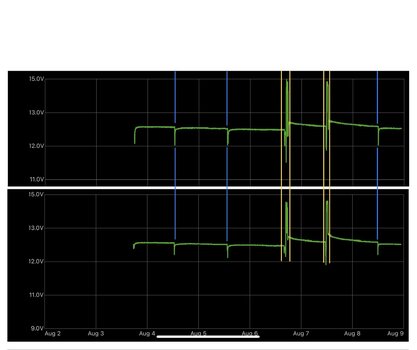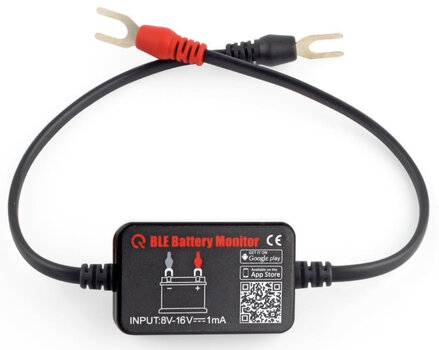The Grenadier Forum
Register a free account today to become a member! Once signed in, you'll be able to contribute to the community by adding your own topics, posts, and connect with other members through your own private inbox! INEOS Agents, Dealers or Commercial vendors please use the contact us link at the bottom of the page.
(The battery and monitor thread )Car dead in the middle of the woods
Would be great to rewire one of the roof outlets so a solar cell can connect to it....As published several times by some clever people here in the forum, see the attachment from the CTEK User Manual.
I connected the 250se to the alternator, not to a solar panel.
Upvote
0
normal usage the last days, no single trip more than 40km.
Battery Bluetooth monitor is nearly similar to Ineos monitor. The auxiliary battery will be charged parallel to starter, and consumer are provided at first from starter. It looks like, that if the difference between the batteries is more than 10% and no charging from engine or external, the auxiliary start to charge the starter.


Battery Bluetooth monitor is nearly similar to Ineos monitor. The auxiliary battery will be charged parallel to starter, and consumer are provided at first from starter. It looks like, that if the difference between the batteries is more than 10% and no charging from engine or external, the auxiliary start to charge the starter.
Upvote
0
@Lollo050968 when the car is running are both batteries being charged by the alternator ?
Do both batteries see the charging voltage (14V) ?
What happens when the smart alternator turns off (charging voltage not present with engine running) ?
Do both batteries see the charging voltage (14V) ?
What happens when the smart alternator turns off (charging voltage not present with engine running) ?
Upvote
0
@Lollo050968 when the car is running are both batteries being charged by the alternator ?
Do both batteries see the charging voltage (14V) ?
What happens when the smart alternator turns off (charging voltage not present with engine running) ?
Yes, both are charged.
At first the starter battery “provide” , than when there’s a difference of xx% (~10%), the auxiliary start to provide too, balance both batteries on a equal level
Upvote
0
That’s my understanding too. The smartpass seems to allow both to be charged via the alternatorYes, both are charged.
At first the starter battery “provide” , than when there’s a difference of xx% (~10%), the auxiliary start to provide too, balance both batteries on a equal level
Upvote
0
I have created a table to understand the percentage readings of the China monitors.
It is (still) completely fuzzy, because I don't have enough values. But you can already see how much the percentages depend on interpretation. I have taken the volt/DoD figures from the pictures posted here. The columns name the respective sources.
The "INEOS" column is the most complete. I used only the "discharge" values, since the "charge" situations seem to show only what the generator delivers, but not the actual battery voltage. This becomes obvious if you see that the voltage values for charging and discharging are completely different at the same DoD percentage.
But also the discharge values are to be taken with caution, because discharging with 8 amps or with 16 amps results in different voltages (although I consider the difference for such large batteries negligible within this current range).
But as an approximation, it is already clear that the INEOS curve is not linear and, to my understanding, seems to be defined with some thought behind it.
I personally trust the INEOS values the most.
If we collect some more readings here I will add them to the diagram.
For the INEOS readings, only report 'discharge' readings with no more than around 15 Amps.

It is (still) completely fuzzy, because I don't have enough values. But you can already see how much the percentages depend on interpretation. I have taken the volt/DoD figures from the pictures posted here. The columns name the respective sources.
The "INEOS" column is the most complete. I used only the "discharge" values, since the "charge" situations seem to show only what the generator delivers, but not the actual battery voltage. This becomes obvious if you see that the voltage values for charging and discharging are completely different at the same DoD percentage.
But also the discharge values are to be taken with caution, because discharging with 8 amps or with 16 amps results in different voltages (although I consider the difference for such large batteries negligible within this current range).
But as an approximation, it is already clear that the INEOS curve is not linear and, to my understanding, seems to be defined with some thought behind it.
I personally trust the INEOS values the most.
If we collect some more readings here I will add them to the diagram.
For the INEOS readings, only report 'discharge' readings with no more than around 15 Amps.
Upvote
0
I am still confused, but feel I can confirm @Lollo050968 ´s observation that both batteries charge up while driving (taken that monitors are somewhat functional).
Blue lines is me turning key (not starting car) to read Ineos voltage and load status info.
Yellow sections is me driving round the forrest to charge up a bit.

What still is confusing:
- massive voltage drop by turning key, as if whole system needs massive energy to prepare for potential start of engine. Is this the way with modern cars?
- parking car loses like 4% of charge (Ineos info) per 24h. Due to super slow load while driving - see below - that gives me only few days with no activity till voltage drop under 12V when parking car in the 70ies %.
- while driving this week the load info on screen was only 1-2A for 95% of the time. So first 45min ride did not change the load % on screen at all. The ride on day after had the % flipping up by 10% in one step after 5 min of driving and then no further change for the remaining 30-40min. I understand that chemical reaction kick in / run with a latency, but assumed system calculated input live?! As I loads from up to 70A displayed during our big trip and changed nothing but adding the battery monitors: can they have an impact on the system?
Maybe something broke also. But very spoiled with old cars starting up after weeks witting outside with no issues.
Would installation of the CTEK 250 also help loading faster when driving or simply add additional load options with plugging, solar power,…?
Thanks.
Blue lines is me turning key (not starting car) to read Ineos voltage and load status info.
Yellow sections is me driving round the forrest to charge up a bit.

What still is confusing:
- massive voltage drop by turning key, as if whole system needs massive energy to prepare for potential start of engine. Is this the way with modern cars?
- parking car loses like 4% of charge (Ineos info) per 24h. Due to super slow load while driving - see below - that gives me only few days with no activity till voltage drop under 12V when parking car in the 70ies %.
- while driving this week the load info on screen was only 1-2A for 95% of the time. So first 45min ride did not change the load % on screen at all. The ride on day after had the % flipping up by 10% in one step after 5 min of driving and then no further change for the remaining 30-40min. I understand that chemical reaction kick in / run with a latency, but assumed system calculated input live?! As I loads from up to 70A displayed during our big trip and changed nothing but adding the battery monitors: can they have an impact on the system?
Maybe something broke also. But very spoiled with old cars starting up after weeks witting outside with no issues.
Would installation of the CTEK 250 also help loading faster when driving or simply add additional load options with plugging, solar power,…?
Thanks.
Last edited:
Upvote
0
Adding to the confusion, I hadI have created a table to understand the percentage readings of the China monitors.
It is (still) completely fuzzy, because I don't have enough values. But you can already see how much the percentages depend on interpretation. I have taken the volt/DoD figures from the pictures posted here. The columns name the respective sources.
The "INEOS" column is the most complete. I used only the "discharge" values, since the "charge" situations seem to show only what the generator delivers, but not the actual battery voltage. This becomes obvious if you see that the voltage values for charging and discharging are completely different at the same DoD percentage.
But also the discharge values are to be taken with caution, because discharging with 8 amps or with 16 amps results in different voltages (although I consider the difference for such large batteries negligible within this current range).
But as an approximation, it is already clear that the INEOS curve is not linear and, to my understanding, seems to be defined with some thought behind it.
I personally trust the INEOS values the most.
If we collect some more readings here I will add them to the diagram.
For the INEOS readings, only report 'discharge' readings with no more than around 15 Amps.
View attachment 7822800
- 12,5 V being 77%
- 12,0 V being 76% as well as 67%
and as it jumps up to 14,x V as soon as you start the car, confirms your statement of it being not worth following that route…
Upvote
0
If diesel, likely due to glow plug/pre-heater and/or fuel pump priming.- massive voltage drop by turning key
The 250SE will charge at 20A whenever the engine is running whereas the Smartpass is dependant on the smart alternator and can only charge the service battery to around 75-80%.Would installation of the CTEK 250 also help loading faster when driving or simply add additional load options with plugging, solar power,…?
When trying to determine a correlation between volts and % SOC, voltages should be measured when the vehicle has been at rest and before turning the key to Access or On. Pre-heaters and fuel pumps can start running causing a voltage drop.
Last edited:
Upvote
0
That's very unlikely.adding the battery monitors: can they have an impact on the system?
Even the cheapest voltmeters have usually an impedance of over 10 K-Ohms (good DMMs have Megohms). With 10 KOhm at 12V they consume only 1.2 mA plus maybe a few for their own electronics.
Absolutely negligible.
Upvote
0
Which kind of reading is this? From the car's display or from your monitor?Adding to the confusion, I had
- 12,5 V being 77%
- 12,0 V being 76% as well as 67%
and as it jumps up to 14,x V as soon as you start the car, confirms your statement of it being not worth following that route…
As I have written above, the voltage readings are misleading upon charging cycles. Although the generator produces 14 Volts or more, this is not the real battery voltage since the battery has an impedance which causes the voltage to stay high.
The current cannot easily flow into the battery, which is why the voltage "accumulates" in front of the battery, so to speak.
Under load, the situation is somewhat different. The batteries are quite large, so that a discharge current of 10 or 15 amperes indeed means a voltage drop on one hand. But this is small. After all, the batteries can easily supply 500 amps or more, so that a load in the lower ampere range is of little consequence for the voltage (as opposed to a charging situation).
This is easier to understand if you take into account that, although a Laed-Acid battery can deliver 500 Amps it is far from being able to digest a charging current of 500 amperes. This means that the discharge has less effect on the battery than the charge at a comparable current. Therefore, the voltage readings are only meningful as long as the battery is not charged at all and not discharged at high current.
Therefore, the voltage readings during the charging cycles are not reliable.
Last edited:
Upvote
0
I'm about to install a 2channel dashcam. "Plan A" is to connect the "constant 12v" lead to the auxiliary/service battery positive ( via a busbar I found in my 'might-be-useful-one-day- treasure -box") and the ignition lead on either heated seat fuse #121 (which is spare because I don't have heated seats).
What I don't "quite" understand is why the Smartpass 120s diagram shows a car fridge attached to the so-called "out" terminal , while other devices such as radios and external lights etc are wired to the positive of the auxiliary battery. Should I attach the busbar to the "out" terminal instead?
What I don't "quite" understand is why the Smartpass 120s diagram shows a car fridge attached to the so-called "out" terminal , while other devices such as radios and external lights etc are wired to the positive of the auxiliary battery. Should I attach the busbar to the "out" terminal instead?
Upvote
0
High draw vs low draw?I'm about to install a 2channel dashcam. "Plan A" is to connect the "constant 12v" lead to the auxiliary/service battery positive ( via a busbar I found in my 'might-be-useful-one-day- treasure -box") and the ignition lead on either heated seat fuse #121 (which is spare because I don't have heated seats).
What I don't "quite" understand is why the Smartpass 120s diagram shows a car fridge attached to the so-called "out" terminal , while other devices such as radios and external lights etc are wired to the positive of the auxiliary battery. Should I attach the busbar to the "out" terminal instead?
Upvote
0
The Smartpass will kill the load when it reaches 11.5V whereas using the battery direct will drop it to dead flat (which can damage the battery). Ctek are saying you might want the UHF to still work below 11.5V as you might see it as a higher priority (emegencies) than say a fridge. I'd go to the sevice battery if the dashcam has a time out setting or voltage cutoff. My Blackvue 750 dual can be set to switch off after so many hours via the App, which I do.What I don't "quite" understand is why the Smartpass 120s diagram shows a car fridge attached to the so-called "out" terminal , while other devices such as radios and external lights etc are wired to the positive of the auxiliary battery. Should I attach the busbar to the "out" terminal instead?
Last edited:
Upvote
0
Many thanks @MarkHThe Smartpass will kill the load when it reaches 11.5V whereas using the battery direct will drop it to dead flat (which can damage the battery). Ctek are saying you might want the UHF is still work below 11.5V as you might see it as a higher priority (emegencies) than say a fridge. I'd go to the sevice battery if the dashcam has a time out setting or voltage cutoff. My Blackvue 750 dual can be set to switch off after so many hours via the App, which I do.
Upvote
0
Has someone started that thread?Hi - I am also waiting to install a D250SE and would love to check how the wiring is done given we already have the 120 installed - for instance ?extra fuses required in the 250 cabling. Perhaps we should start a new thread to share the experience of adding a 250 as I am sure a few will be doing it.
Planning to add the 250 this weekend and very much interested in not breaking things doing things in the wrong order.
Upvote
0
Trialmaster diesel with the high load electrical fitout:
Here's a "curley"one: I built a portable 100AH LiFeP04 battery box with a "Projecta" IDC25L DC-DC charger (25A) attached. (It also accepts solar with an inbuilt MPPT controller for the LiFeP04 battery).
.
If I connect the Projecta DC-DC charger 12V signal wire to an ignition-controlled 12V fuse, is that likely to impact the Smartpass 120s operation even though the alternator will be responding to the Projecta charger, not the Smartpass... or will all (3) batteries benefit from the altered activity of the smart alternator ?
Here's a "curley"one: I built a portable 100AH LiFeP04 battery box with a "Projecta" IDC25L DC-DC charger (25A) attached. (It also accepts solar with an inbuilt MPPT controller for the LiFeP04 battery).
.
If I connect the Projecta DC-DC charger 12V signal wire to an ignition-controlled 12V fuse, is that likely to impact the Smartpass 120s operation even though the alternator will be responding to the Projecta charger, not the Smartpass... or will all (3) batteries benefit from the altered activity of the smart alternator ?
Last edited:
Upvote
0
@DenisM - It's a good question.
I think the car's ECU is controlling the smart alternator and it is getting it's info from the main battery rather than from the Aux.
It's not the smartpass that is determining charge as this is reportedly not connected to the alternator.
Several members now have independant battery monitors so the charging method should be exposed soon.
I don't think that attaching another DC/DC charger will effect the activity of the alternator, although, to be fair, I am only guessing.
The downside may be that the battery won't charge adequately as it will be subject to the status of the main battery, ie if thats charged then the alternator turns off.
We may need to experiment (if someone is willing) by reducing the charge in the AUX and charging the main to 100%.
When everything is reconnectd, does the car charge the AUX in preference to the main, will it charge it at all if the main is at 100%.
I think the car's ECU is controlling the smart alternator and it is getting it's info from the main battery rather than from the Aux.
It's not the smartpass that is determining charge as this is reportedly not connected to the alternator.
Several members now have independant battery monitors so the charging method should be exposed soon.
I don't think that attaching another DC/DC charger will effect the activity of the alternator, although, to be fair, I am only guessing.
The downside may be that the battery won't charge adequately as it will be subject to the status of the main battery, ie if thats charged then the alternator turns off.
We may need to experiment (if someone is willing) by reducing the charge in the AUX and charging the main to 100%.
When everything is reconnectd, does the car charge the AUX in preference to the main, will it charge it at all if the main is at 100%.
Upvote
0
If I connect the Projecta DC-DC charger 12V signal wire to an ignition-controlled 12V fuse, is that likely to impact the Smartpass 120s operation even though the alternator will be responding to the Projecta charger, not the Smartpass... or will all (3) batteries benefit from the altered activity of the smart alternator ?
It should benefit the service battery while the Projecta is in its bulk & absorption stages as the SP (Smartpass) can utilise the alternator's higher voltage, but once the Projecta goes to float (13.5V) the alternator will throttle back I'd say. DC chargers create a load on the starter which triggers the alternator to throttle up.
The SP is governed somewhat by the service battery's SOC (state of charge) so if it's down at say 50% the SP will output all it can but is dependant on what the alternator is doing as the SP can't boost the charge like the Projecta to create the required load on the starter. But if you connect the SP's ignition wire then it will remain 'On' and continue to charge albeit slowly, as it's still dependant on the alternator & SOC, (can't fathom why Ineos left it disconnected). As the service battery's SOC rises, resistance in the battery rises and without a 250SE to boost the charge to overcome it the SP on its own can only achieve ~80% SOC at best.
Bit more to it but that's the gist of it.
Last edited:
Upvote
0
Similar threads
- Replies
- 14
- Views
- 641
- Replies
- 51
- Views
- 4K
- Replies
- 26
- Views
- 2K
- Replies
- 36
- Views
- 3K




